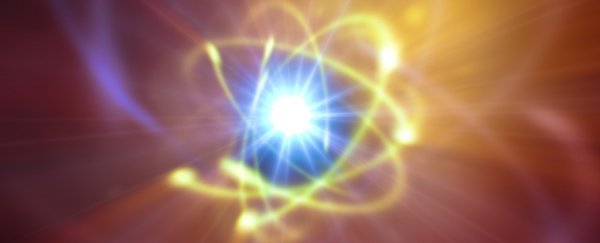Protons probably aren't quite as big as we'd once imagined, according to the results of a sensitive physics experiment that took eight years to complete.
Scientists now say our earlier measurements of proton size were off by as much as 5 percent – which might not seem like such a huge correction, but to physicists the puzzle of the incredible shrinking proton has been begging for a solution for years.
In fact, the problem has been nagging at scientists ever since a new way to measure the particle cast doubt on earlier findings. The latest figure, as determined by a team of researchers in Canada, puts the proton's radius at around 0.833 femtometres; a smidgeon off the 0.842 femtometres calculated by a landmark 2010 experiment.
Coming up with the result was no easy task, either, blending methods from multiple experiments to determine once and for all which is most likely to be right.
"The level of precision required to determine the proton size made this the most difficult measurement our laboratory has ever attempted," says York University physicist Eric Hessels.
Unlike the convenient models of atoms in our text books, protons aren't like smooth little spheres. Lacking a distinct surface, the proton is instead a cloud defined by a threshold in its positive charge.
To put a distance on the extent of this boundary, you could use one of two methods.
One is to fire negatively charged particles at the nuclei of hydrogen atoms and keep track of how they ricochet off. Shoot enough electrons, and you should be able to trace a pattern that tells you where the positive charge of the proton starts to fade.
This approach has been conducted numerous times over the years, and the figures generally hover around the 0.88-femtometre mark.
Method number two is a little less aggressive, relying instead on detecting changes in an electron's energy levels as it orbits a proton.
In more technical terms, measurements are based on the weird fuzziness of quantum mechanics, which suggests particles don't always have a clear position. This means electrons occasionally find themselves in the dead heart of a proton, pulled equally on all sides.
Differences in energy states of an excited electron as it occasionally finds itself inside a proton were first quantified some 70 years ago by Nobel laureate Wallis Lamb, and the method remains a handy way to estimate the proton's radius to this day.
Most measurements based on the so-called Lamb Shift have more or less agreed with one another, so in 2014 the Committee on Data for Science and Technology settled on an official distance of 0.875 femtometres.
'Most' doesn't mean 'all', though. That pesky 2010 experiment failed to come anywhere near this number, and has remained a fly in the ointment every since.
By swapping an electron for its heavyweight relative, the muon, the negatively charged particle in hydrogen's orbit would spend more time dipping inside its proton, adding precision to measurements of its radius.
The Lamb Shift of this exotic form of hydrogen in the 2010 experiment suggested that the proton's radius was a whole 4 percent less than the official figure.
Unfortunately, the sensitivity of the method was too great to dismiss out of hand. Since then, repeated experiments using muons have come up with similar numbers.
Against this backdrop, Hessels and his team went about performing the classic Lamb Shift method once again by returning to the traditional electron. Only, this time, they made use of a relatively new technique called FOSOF – short for frequency-offset separated oscillatory fields.
This approach allowed them to carry out the experiment with the extraordinary precision of the muon method, only without the muon.
Their result is a touch smaller than the 2010 result, but is still in enough agreement to suggest we're onto something.
"After eight years of working on this experiment, we are pleased to record such a high-precision measurement that helps to solve the elusive proton-radius puzzle," says Hessels.
As it happens, the result means there's probably no new physics behind the discrepancy, so we should rule out challenges to the standard model.
But it does mean we could soon have agreement on just how wide a proton might be.
Two years ago, the proton's mass also required a small adjustment. Unless pending experiments that continue to poke the proton's edges continue to throw up surprises, it's looking like the proton's waistline isn't quite what it used to be.
This research was published in Science.
